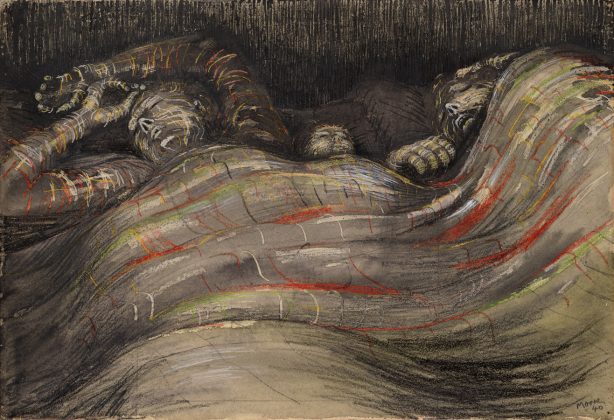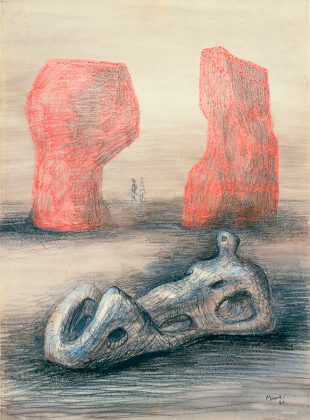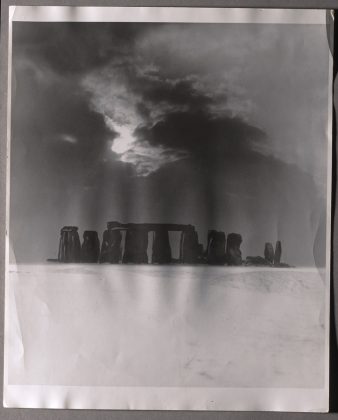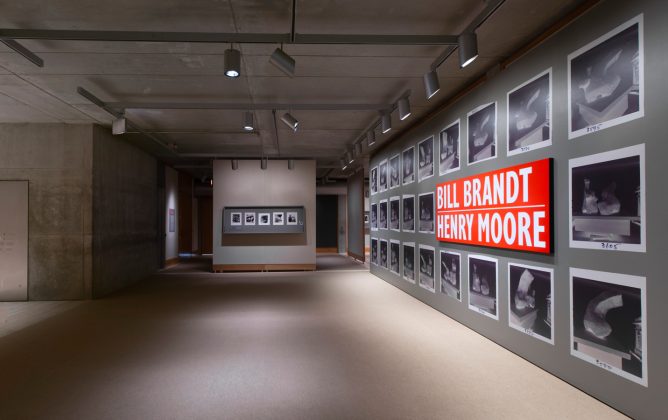The British photographer Bill Brandt and British sculptor Henry Moore were both employed by England’s government to document the effects of the Blitz (the German bombing campaign directed toward London and other Englisch locales in 1940-41), especially the civilians sleeping in London’s Underground. Brandt contributed photographs of huddled groups lying on subway platforms, while Moore produced drawings. The show, comprising these art efforts (as well as later works), along with Moore’s sculpture and a film documenting the undertaking, illustrates how two major artists created memorable work under duress, in the face of the deadly air attacks by the Nazis. Even during the war, magazines began to present articles in which Brandt and Moore were included together. Their art, now on exhibition at Yale’s Center for British Art, works in providing insight into the early practice of artists central to British modernism. It also surveys the very difficult life lived under siege. Later work in the show examines how Brandt and Moore returned to imageries in alignment with nature, perhaps as a way of repairing their vision after the trauma of the German bombings. British culture has brilliantly addressed nature since their Romantic period–think of Wordsworth’s poetry and the art of Constable and Turner. The early imagery in this show is very urban, but the later works of art by both Brandt and Moore focus on the rendering of nature.
How does an artist effectively portray the scars of military conflict? Goya’s painting, The Third of May (1805), characterized as the first modern painting, shows the execution of Spaniards fighting the Napoleon’s army. , It depicts a scene of great violence with memorable pathos. There is also Goya’s 85 prints comprising The Disasters of War (1810-20), which describe violence in graphic detail. Then, later, German expressionist Otto Dix originated an extraordinary group of prints called The War (1924), based on his experiences in the First World War. These images, often grisly, showed the bloody damages troops underwent during that conflict. In contrast, Brandt and Moore create no works showing actual fighting; instead, the suggestion of violence looms over the art, which picture underground stations shrouded in darkness, their floors crowded with civilians trying to rest. The anarchic disarray and harm of wartime is implied, not truly shown. Now that we can watch, in real time, fighting in the Ukraine, art cannot easily match the grim vividness of live combat. When the British government employed Brandt and Moore for documentation of war’s effects, both men looked to imply the conflict rather than literally portray it. Their work is unusually eloquent in regard to the harshness of the Blitz, even if we never see bombs falling. As Brandt / Moore demonstrates, an indirect presentation of struggle can be more effective than a genuinely accurate representation.
Photography’s precision in regard to experience is particularly well suited to the struggles of war. Brandt, a major photographer, engaged in the presentation of civilian suffering that resulted from the Blitz. In documentary work, we treat the photograph as an accurate depiction of the reality we see, and Brandt’s moving studies of people sleeping in the tunnels record war’s extreme duress, albeit indirectly. But while the photograph’s detailed precision holds more visual truth than the more interpretive efforts of a painting or drawing, its visual particularity can sometimes constrain the emotional effects of its subject matter. In contrast, the drawings of Moore, which in this show are outstanding, inevitably present a view at some distance from the actual situation, and are less exact but more evocative. Viewed together, the works of both artists represent a reading of war’s secondary effects that neither man alone would be able to fully convey.
Moore’s 1940 drawing, named Sleeping Shelterers: Two Women and a Child, is a work done entirely in dark brown. Three sleepers, two women on either side of a child in the middle, are covered by a large, thick, brown blanket embellished with streaks of red. They sleep against a monolithic wall that rises up to the top of the drawing. The woman on the left has a large head, her features highlighted in white. Her hands extend above her head. The child in the middle is nearly enveloped in darkness; her features are hard to see, given the atmospheric gloom surrounding her and the blanket pulled up to her chin. And the woman on the right sleeps on her side, so that her body rises above the other two. Her large hand, large to the point of being strange, rests between her head and that of the child. A study with strong, nearly academic drawing merits, Sleeping Shelterers portrays what must have been the claustrophobic results of so many strangers sleeping next to each other in the gloom of the subway. The blanket comes close to looking like a heaving sea, and behind the figures, the wall, which consists of black lines against brown, emphasizes the darkness of the interior. As beautifully executed as the drawing is, it is seen most usefully as an interpretation of experience, not a document of truth, in the way we would understand a photograph
The major structural component of Bill Brandt’s Liverpool Street Extension (1940) is the curved ceiling of the Underground, which takes up the top half of the photograph. Beneath the vault is an anarchic situation: people resting this way and that, their disparate bodies and garments creating a world of chaos. Perhaps this is the way war is always experienced–as a massive display of confusion. One needn’t see the planes flying overhead, or the bombs being dropped, to register the effects of war depicted in this photo. The theme given both Brandt and Moore–the depiction of civilians during wartime–was relatively narrow, but the two artists were able to show the terrible effects of the violence the Germans were directing toward the British at the time. They did this without adding overt evidence of military aggression. In depicting so traumatic a situation as war, there are ways of communicating its destructiveness by inferral rather than by direct report. Looking at Brandt’s Liverpool image, one senses the utter lack of coherence brought about by armed conflict. Yet Liverpool Street Extension does this by implication. Other photographers, since the First World War, or even earlier, during the American Civil War, conveyed the brutality of battle in images of actual fighting, wounded soldiers, and the recent dead. But Brandt’s image conveys a similar confusion without dwelling on violence.
In Morning after the Blitz (1941), Moore used pencil, watercolor, and chalk to depict small groups of thin black figures, mostly in the bottom half of the work. They face a street leading beyond them; the pavement is highlighted by white scribbles of chalk. It is hard to determine what the highest part of the image contains, but on either side of the street is a building, seemingly still intact, albeit with blown-out windows. The entire drawing is given a faded brown color, with a couple of skeletal trees on the left. Here, again, we don’t see actual violence taking place, only the pathos of its aftermath. The distancing brought about by the fact that this is art–a drawing and not a photo–underscores art’s ability to fashion a world evocative of events without replicating their actuality in particular. As this show demonstrates, neither fine art nor photography is to be preferred, one over the other; instead, different emotional complexities are derived from differing mediums. Thus, Moore’s drawing encapsulates a mood rather than a set of details. Yet enough specificity is given for his audience to draw the conclusion that the consequences of the Blitz were not ephemeral, but lasting, in both an emotional and an architectural way. Instead of the photographic moment, practiced so well by Brandt, we see in Moore’s art a desloate atmosphere. It drifts across the paper, darkening our impression of people, buildings, trees. As a result, Moore’s art advances the recognition of war’s tragic effects on a civilian population.
The show also follows the work of Brandt and Moore after the war. Freed of their journalistic responsibilities to cover the effects of the bombings on civilians, both men looked to nature for their subjects, perhaps as a way of transforming the severity of their wartime experience. The show includes small sculptures by Moore, but these maquettes do not matchthe effect of his large, three-dimensional works, semi-abstract in form and regularly placed in the countryside. The drawing Sculpture and Red Rocks, made with crayon and ink on paper, was in fact created in 1942, while the war was still on, but it is useful in showing Moore’s interest in shapes informed by nature. The sculpture in the drawing, rendered in gray, consists of a reclining female figure with a small head. Holes puncture the form, a stylistic technique effect Moore used regularly in his three-dimensional works. Above the drawing of the female figure are two red rocks, whose volume and outline occur in ways that accentuate their sculptural presence. These rocks are not actual objects, only drawings of them. Yet their form suggests something genuinely volumetric–and nearly convince us that their weight is three-dimensional. Moore’s penchant for an art in conversation with nature is very clear here, and it would lead him further into this area, as the later work in the show attests.
There is one sheet of photographs, of arranged flints, that Moore made in the early 1960s; nine black-and-white images, set on low pedestals, of small flints that look astonishingly monumental in their placement. The small works of art in the photos closely resemble the large sculptural pieces Moore made for the English meadows. The background of each photo, black but with a white mist, contrasts with the flint works set before the ground. Here Moore is taking photographs of his own work, in a way that emphasizes the volume of the image. Sculpture, known for its difficulty in being photographed, is here approached in pictures with real skill. These nine small images remind us that the artist created sculptures suggesting rock formations, as Sculpture and Red Rocks implies. Today, art referring to nature often lacks an inspired characterization; the countryside feels distant, outside our knowledge. We have become too urbanized, and too reliant on technology, to fully appreciate the landscape. But Moore’s creative undertakings took place when the English rural setting was still possible to portray in an unjaded fashion.
Brandt also moved toward nature in his photography after the war. His 1947 photo, Stonehenge Under Snow, is truly dramatic, being an image of the circular prehistoric monument located on Salisbury Plain in central southern Britain. The massive structure consists of a circle of vertical slabs of stone, each waying tons, with three horizontal slabs acting as lintels for the standing elements. In Brandt’s picture is taken in near darkness; mystery surrounds the stone circle. The sky is nearly empty of light, past twilight, while Stoneheng itself rises up with a good expanse of snow fronting it. The sky itself is as mysterious as the monument; the moon illuminates a patch of clouds in the upper center left, while columnar shadows fall from the stone onto the snow and even seem to rise up behind the slabs into the evening. The image is so boldly expressed as to border on the melodramatic, although this doesn’t quite happen. Stonehenge remains a monumental icon in England today, albeit one that has been commercialized, and Brandt’s photograph, shot at a time when the structure still retained its chthonic power and had not been overtaken by tourism, captures the ties between elemental culture and the mysteries of the sky.
In 1959, Brandt shot a beautiful photo of a body resting on stones polished by the sea. Called Baie des Anges, the image consists of what seems to be a body on its back, with a bent arm in front of it. Rounded, mostly white stones, made smooth by water, fill the lower space in front of the body. The title of the photograph refers to a large bay located in the Mediterranean, near Nice. The picture is not so much erotic as it is sensuous, being roughly divided into thirds: a cloudless sky at the top; the torso and angled arm placed in the middle; and the stones occupying the lower third of the composition. There is the softness of flesh and the hardness of stone in juxtaposition to each other. The contrast is highly attractive and brings into play textures and densities that keep the image very much alive. In this picture, Brandt proves he is just as adept at closeups as he is photographing from a distance. But in both images discussed here, he witnesses nature with an ability remarkable both for its large conception and specific detail.
In summary, Brandt’s 1948 photographic portrait, Henry Moore, shows the sculptor and draftsman sitting on the right, with a large figurative wooden carving before him. His manner in this image is sober but not melancholic; the torso of the sculpture, a reclining figure, is emphasized. Behind Moore we see the white panels of a house. Brandt was notably gifted in catching artists in their essence–there is, for example, a remarkable study of the painter Francis Bacon walking in London taken in 1963. In Brandt’s image of Moore, one senses a seriousness of purpose; Moore’s esthetic, both very old and very new, enhances the image even though it is impossible to see. The exhibition demonstrates how both artists took on more than one theme, making it clear that their interest in lyricism hovered over everything they did. This show, scholarly as well as directed toward the general public, makes the point that artists who work with history, either archaic, recent, or in the making, place their hopes on a point of view that recognizes the past. In this exhibition, then, the past cannot be dismissed. Now that the imageries of both artists are decades old, a sense of the past has come to inhabit the work seen in this show. But the feeling of lost time, in conjunction with the dark implications of the imagery, invests their artworks with a high seriousness. The images I describe come from history now–a period we can only recover rather than live through. Both artists are gone, but the art holds purpose. Thus, the pictures and drawings in the show become vehicles for understanding the gravity of war, while the later work shows a willingness to move on and address new themes. The gap in time between the art’s production and the much later moment of the exhibition hopefully bridges then and now, even if the experiences depicted remain distant from contemporary life. Brandt and Mooore’s photography and photographs keep the memory of wartime events and scenes alive. Their work, like all strong art, has a way of projecting visual and even ethical values into the future.
Texto en español














